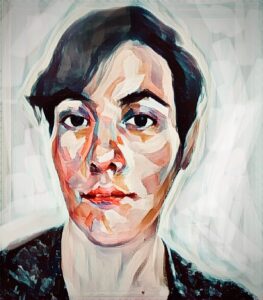
Ilya Noé is a former gymnast turned visual/performance artist-researcher, compulsive walker (and talker), beginner backstrap weaver, (over)eager collaborator, and fan of tea, deer, trees, fungi, foxes, interspecies entanglements, mutualistic processes, tao(ist dia)lectics, slow research, messy theory, intellectual promiscuity, epistemological uncertainty, open-ended storytellings, ellipses…
Born and mostly assembled in Mexico City, she moved to New York City to study painting and sculpture at the School of Visual Arts when she was still a teen, and has since expanded her operations and zone of propagation by popping up on all sides of the Atlantic and the Pacific to trace lines and build spaces by hand, on foot, and in co-creation with both humans and non-humans alike. She now lives, loves, involves, and revolves mostly around Berlin.
Ilya has presented her work at the 12th Biennale of Shanghai, represented her country in Venice’s OPEN2000, became a UNESCO-Aschberg Laureate and was recipient of one of Mexico’s National Young Art Awards. A special guest at both the European Landscape Biennial in Barcelona and the International Biennial of Cerveira, she has also shown at the Boston Center for the Arts (USA), Centre d’Art Santa Mónica (Barcelona), Centro Nacional de las Artes (Mexico), AC Institute (New York), Seika University Art Gallery (Japan), TRAFO (Poland), Excentricités Festival (France), Visions_V (Greece), Performensk (Belarus), Pavilion Milchhof (Berlin), among others. She has been artist-in-residence at the Banff Centre for the Arts (Canada), Zentrum für Kunst und Urbanistik (Berlin), Campo Arqueológico de Mértola (Portugal), Museu de Sant Pol (Barcelona), and MacLaughlin Natural Reserve (California), among other prestigious institutions. Her work is represented in European and North American public collections.
Moved by the non-metaphoric intimacy between plants and mushrooms, Ilya has been busy for the past decade or so trying to articulate a (po)ethics of collaboration and “erosurrogation” in both practice and theory. Along with her embodied concepts of the “sporadic” and the “sporous”, and her attempted move from site-specificity to “eco-particularity”, she insists on devising strategies that push her subjectivity and entanglements into walking (and weaving) more distributed and co-extensive pathways.

